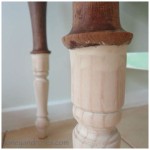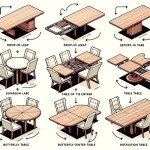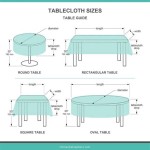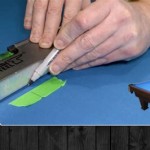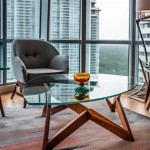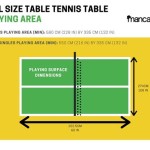Acrylic Glass Table Top: A Comprehensive Overview
Acrylic glass, also known as polymethyl methacrylate (PMMA), has emerged as a popular material for table tops due to its unique combination of aesthetic appeal, durability, and versatility. It offers a compelling alternative to traditional glass and other materials, presenting a range of advantages that make it a suitable choice for various applications, from residential dining tables to commercial displays.
This article provides a comprehensive exploration of acrylic glass table tops, examining their properties, benefits, applications, considerations for selection, and care instructions. The information presented aims to offer a clear understanding of the material and its suitability for different needs and preferences.
Understanding Acrylic Glass
Acrylic glass is a synthetic polymer that is transparent, rigid, and lightweight. It is produced through the polymerization of methyl methacrylate monomer. The resulting material exhibits several key characteristics that contribute to its widespread use in table top applications:
Transparency: Acrylic glass boasts exceptional optical clarity, often surpassing that of traditional glass. It allows for high light transmission, making it ideal for showcasing items beneath the surface or creating a bright and airy ambiance.
Impact Resistance: Compared to traditional glass, acrylic glass is significantly more impact resistant. This reduces the risk of shattering and makes it a safer option, especially in homes with children or pets, or in high-traffic commercial environments. While not unbreakable, it is substantially less prone to fragmentation upon impact.
Lightweight: Acrylic glass is considerably lighter than traditional glass, typically weighing about half as much. This makes it easier to handle during installation and transportation, and it also reduces the strain on the table frame or supporting structure.
UV Resistance: Many acrylic glass formulations are UV resistant, meaning they are less likely to yellow or degrade upon prolonged exposure to sunlight. This is a crucial factor for table tops that will be placed near windows or outdoors.
Machinability and Formability: Acrylic glass is relatively easy to cut, drill, and shape using standard woodworking tools. This allows for greater design flexibility and customization, enabling the creation of table tops in various sizes, shapes, and edge profiles.
Chemical Resistance: Acrylic glass exhibits good resistance to many common chemicals, including acids, alkalis, and solvents. However, it is important to verify the specific chemical resistance of a particular grade of acrylic glass before using it in environments with exposure to harsh chemicals.
Thermal Properties: Acrylic glass has a relatively low thermal conductivity, which means it does not transfer heat or cold as readily as some other materials. This can make it more comfortable to the touch, especially in extreme temperatures.
Benefits of Choosing an Acrylic Glass Table Top
Selecting an acrylic glass table top offers a multitude of advantages over alternative materials. These benefits contribute to its growing popularity in both residential and commercial settings:
Enhanced Aesthetics: The exceptional clarity and smooth surface of acrylic glass lend an elegant and modern aesthetic to any space. It can be easily colored or tinted to complement different design schemes, offering a wide range of visual possibilities.
Improved Safety: The higher impact resistance of acrylic glass compared to traditional glass significantly reduces the risk of shattering and creating sharp, dangerous fragments. This makes it a safer choice for households with children or pets, and for public spaces.
Increased Durability: Acrylic glass is a durable material that can withstand daily wear and tear. Its UV resistance helps prevent yellowing or discoloration, ensuring that the table top maintains its appearance over time. Proper care and maintenance will further extend its lifespan.
Design Flexibility: The machinability and formability of acrylic glass allow for a high degree of design flexibility. Table tops can be fabricated in various shapes, sizes, and thicknesses to meet specific needs and preferences. Complex designs and custom edge profiles are readily achievable.
Easy Maintenance: Acrylic glass is relatively easy to clean and maintain. Dust and dirt can be removed with a soft cloth and a mild detergent solution. Polishes specifically designed for acrylic can be used to remove scratches and restore the surface's shine.
Weight Advantage: The lighter weight of acrylic glass compared to traditional glass simplifies installation and reduces the load on the table frame. This is particularly beneficial for large table tops or tables with delicate frames.
Cost-Effectiveness: While the initial cost of acrylic glass may be higher than that of some other materials, its durability and longevity can make it a cost-effective option in the long run. The reduced risk of breakage and the minimal maintenance requirements contribute to its overall value.
Applications of Acrylic Glass Table Tops
The versatility of acrylic glass table tops makes them suitable for a wide range of applications in both residential and commercial settings. Some common applications include:
Dining Tables: Acrylic glass table tops provide a sleek and modern surface for dining, offering excellent clarity and durability. They can be paired with various table bases, from metal to wood, to create a unique and stylish dining experience.
Coffee Tables: Acrylic glass coffee tables are a popular choice for living rooms and entertainment areas. Their transparency allows for showcasing decorative items beneath the surface, while their durability ensures they can withstand everyday use.
Side Tables: Acrylic glass side tables offer a contemporary touch to bedrooms, living rooms, and hallways. They can be used to display lamps, books, or other decorative items, adding a touch of elegance to any space.
Office Desks: Acrylic glass desk tops provide a clean and professional workspace, offering a smooth and durable surface for writing and computer use. Their transparency can also help to create a more open and collaborative work environment.
Display Cases: Acrylic glass is widely used in display cases to protect and showcase valuable items, such as jewelry, collectibles, and museum artifacts. Its clarity and UV resistance ensure that the displayed items are visible and protected from damage.
Restaurant Tables: Acrylic glass table tops are a durable and hygienic option for restaurants and cafes. They are easy to clean and maintain, and they can withstand the rigors of high-traffic environments.
Outdoor Furniture: UV-resistant acrylic glass can be used for outdoor table tops, providing a durable and weather-resistant surface for patios, decks, and gardens. Its resistance to yellowing ensures that it maintains its appearance even after prolonged exposure to sunlight.
Considerations for Selecting an Acrylic Glass Table Top
When selecting an acrylic glass table top, several factors should be considered to ensure that it meets the specific needs and preferences of the user:
Thickness: The thickness of the acrylic glass will determine its strength and durability. Thicker table tops are generally more resistant to impact and bending. The appropriate thickness will depend on the size and design of the table and the expected load it will bear.
Clarity: Acrylic glass is available in various grades of clarity. For applications where maximum transparency is desired, such as display cases, a high-clarity grade should be selected. Tinted or colored acrylic glass may be preferred for aesthetic purposes or to reduce glare.
UV Resistance: For table tops that will be exposed to sunlight, UV resistance is a critical consideration. Ensure that the acrylic glass is specifically formulated to resist yellowing and degradation from UV exposure.
Edge Treatment: The edge treatment of the acrylic glass table top can significantly affect its appearance and safety. Options include polished edges, beveled edges, and rounded edges. Polished edges provide a clean and modern look, while rounded edges are safer, especially for households with children.
Size and Shape: The size and shape of the acrylic glass table top should be carefully considered to ensure that it fits the intended space and complements the surrounding décor. Custom sizes and shapes are readily available, allowing for maximum design flexibility.
Frame Compatibility: The acrylic glass table top must be compatible with the table frame or supporting structure. The weight of the acrylic glass should be considered, and the frame should be strong enough to support it without bending or buckling.
Supplier Reputation: It is important to choose a reputable supplier of acrylic glass table tops to ensure that the material is of high quality and meets the specified specifications. Look for suppliers with a proven track record of providing durable and reliable products.
Care and Maintenance of Acrylic Glass Table Tops
Proper care and maintenance are essential to preserving the appearance and longevity of acrylic glass table tops. Following these guidelines will help to keep the table top looking its best:
Regular Cleaning: Dust and dirt should be removed regularly with a soft, lint-free cloth. A mild detergent solution can be used to remove fingerprints and smudges. Avoid using abrasive cleaners or scouring pads, as these can scratch the surface.
Scratch Removal: Minor scratches can often be removed with a specialized acrylic polish. Follow the manufacturer's instructions carefully, and test the polish on an inconspicuous area first.
Avoiding Harsh Chemicals: Avoid exposing acrylic glass table tops to harsh chemicals, such as solvents, acetone, or ammonia. These chemicals can damage the surface and cause discoloration.
Protection from Heat: While acrylic glass has a relatively low thermal conductivity, it is still susceptible to damage from extreme heat. Avoid placing hot objects directly on the surface of the table top.
Proper Support: Ensure that the table top is properly supported by the table frame or supporting structure. Uneven support can cause stress and cracking.
Storing Properly: When storing acrylic glass table tops, protect them from scratches and impacts by wrapping them in a soft cloth or foam padding.
By understanding the properties, benefits, and applications of acrylic glass table tops, and by following proper care and maintenance procedures, users can enjoy the beauty and durability of this versatile material for many years to come.

Table Top Cover Protection Acrylic Sheets Shapesplastics

A Perfect Replacement To Glass Tabletops Acrylic Tabletop

Coloured Table Top Furniture Protectors In All Shapes Sizes

Acrylic Table Tops Protectors Plastic Covers For Tables

Larger Clear Round Acrylic Tabletop Cover Protector To Keep

Glass Vs Plexiglas Which One Is More Steady And Strong Option

Acrylic Tables Outdoor Dining Tropitone

Acrylic Table Tops Protectors Plastic Covers For Tables

Acrylic Glass Table Top With Rubber Corks Round Ø 35 Cm Frosted White Willkommen Im Spider Evoflex

Durable Alternative Of Clear Glass Tabletop Replacement

